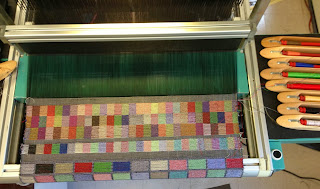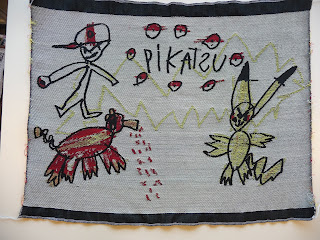One month into joining DWN, I wanted to start weaving and get to know TC-2
better.
After discussion with Vibeke, I decided to weave a drawing done by my 6
year old best friend.
Say hi to Pikachu/Pokemon. The below is the
scanned version of the drawing.
See below
of how the file looks like in black and white (after colour manipulation in
Photoshop) which we uploaded into our loom software to start weaving.
During the process:
The weaving
took me roughly between 2 to 3 hours. The entire experience is very engaging
and the throwing of the shuttles back and forth is actually very therapeutic!
As you can
see from the picture below, the warp yarn is black and I only needed a white
thread for the shuttle to get the below effects.
I am simply
proud and amazed by how our TC-2 is so easy to use.
The final
product:
Not too bad
for a first timer! I am quite proud of myself!
After two
weeks, Vibeke decided that I can work on weaving with more colours.
Using the
same scanned picture, it was toned to 6 colours in Photoshop so it turned out as
below, which was 99% identical to the actual drawing!
During the process:
We were
still on the black warp yarn, but because of the colours involved, I had to use
3 shuttles – White, Yellow and Red.
It took me
6 hours to weave this. I didn’t even make any mistakes or missed a
shuttle/thread because using our TC-2 is so straightforward.
With our
software monitoring the progress, chances of making any mistakes is low.
 |
| Close up of the weaving. See how our TC-2 is able to create such details and mixture of colours using the Red and Yellow threads! |
For a
beginner with zero experience in weaving, I think I did a pretty good job! I
account that to the ease of use of TC-2, along with our smart loom software.
All you
need is a scanner, computer, any design software (Photoshop for example) and a
TC-2.
Anything
and everything is possible to weave with our TC-2.
For those with kids and want
to retain your kids’ masterpieces in fabric, you seriously need our TC-2!
Now, I am
going to decide what to do with the pieces.
- Evie Khoo














































